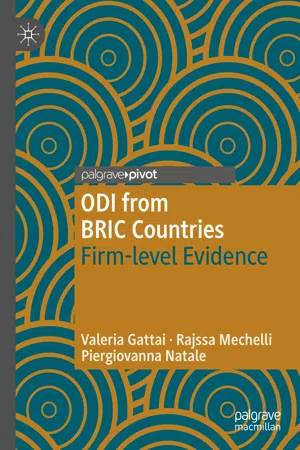According to the last data made available by the United Nations Conference on Trade and Development (UNCTAD), in 2016 China was the third largest recipient of Foreign Direct Investment (FDI)1 in the world, attracting 7.6% of the total Inward Direct Invesment (IDI) flows, up from 1% one decade earlier. In the same year, China ranked second among foreign investors and its share in the total outward FDI (Outward Direct Investment—ODI) flows peaked at 13%, up from 1.3% in 2005–2007 (UNCTAD 2017).
In 2016, India was third in UNCTAD Business Survey of top prospective host economies for 2017–2019 (UNCTAD 2017). In the same year, ODI stocks from India as percentage of GDP reached 6.3%, up from 0.14% in 1995.
These figures testify to the growing importance of ODI from China and India and unquestionably challenge the old view of these countries as low-cost manufacturing locations (Schuller and Turner 2005; Child and Rodrigues 2005; Demirbas et al. 2013). A vast literature has developed analyzing ODI from China and the main characteristics of Chinese Multinational Enterprises (MNEs)2 (for a survey, see Deng 2012, 2013). On a different scale, ODI from India is also the subject of a number of studies attempting to portray some key features of Indian investors (for a survey, see Paul and Benito 2017).
However, China and India are not the only countries characterized by such a fast and impressive surge in ODI: Among developing3 economies, Brazil and Russia are also important sources of multinational activity (Ramamurti 2008, 2012; Ramamurti and Singh 2008; Sauvant 2008; UNCTAD 2015). Combined with China and India, the overall outflows of the so-called BRIC countries (Brazil, Russia, India, and China) increased by 125% and their overall outstocks rose by 338% over the last decade. The surge in ODI originating from BRIC countries is even more striking when compared with ODI flows and stocks from developing economies or from developed countries. From 2006 to 2016, ODI flows from the former increased by 83%, whereas ODI flows from the latter decreased by 6.8%. In 2016, outstocks from developing and developed economies exceeded the 2006 values by 248% and 52% respectively.
What is behind these impressive figures? Who is responsible for the outstanding ODI performance of BRIC countries? Clearly, nations do not engage in ODI: Firms do. Therefore, aggregated ODI volumes should be better understood through firm-level analysis (Mayer and Ottaviano 2007).
This is the chance we seize in this book, by empirically analyzing the ODI involvement of BRIC firms and the relationship between ODI involvement and firm-level performance.
Our approach is inspired by the debate on the internationalization-performance nexus. This debate, spurred in the 1990s by the availability of export firm-level data for the first time (Helpman 2011), is still alive among policymakers and scholars of International Economics.4 Starting with the seminal work of Bernard and Jensen (1995), a large number of contributions have documented that internationalized firms are in the minority, but they outperform domestic enterprises (for a survey, see Lopez 2005; Wagner 2007, 2012, 2016; Greenaway and Knel...
